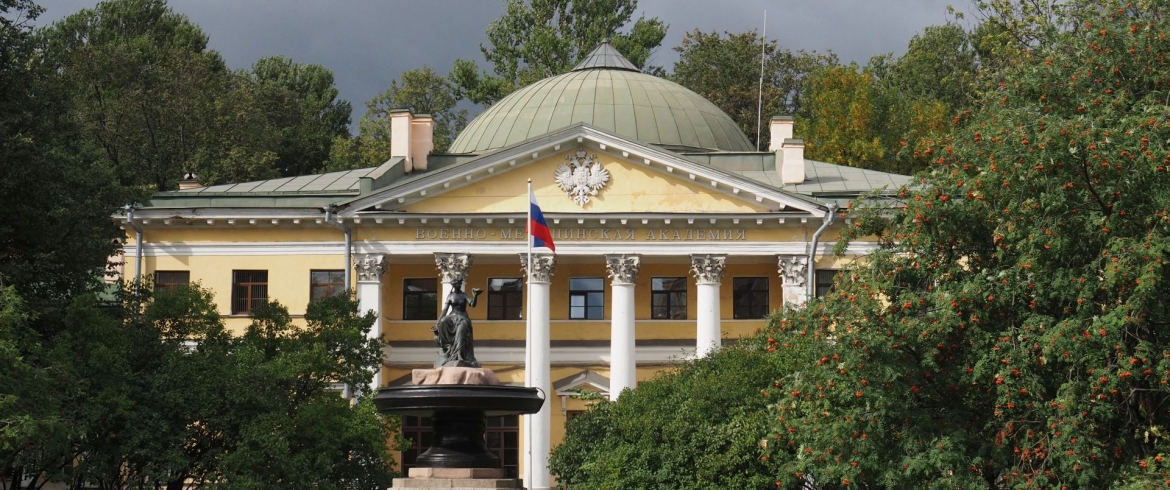Famous building
WMA in the name of Kirov

The official day of the establishment of the Academy is considered to be December 18 (29), 1798, when Emperor Paul I signed a decree "on ... establishing at the main hospitals a special building for a medical school and educational theaters." The initiator of the birth of the Academy was the chief director of the Medical College, Baron A.I. Vasiliev, who presented a special report to the emperor, in which he convincingly substantiated the need to create a Medical and Surgical School as a center for the training of qualified medical personnel. Soon the school was renamed the Medical and Surgical Academy, and in 1808, Alexander I gave it the right to be called the Imperial.
Along with medical, the Academy also laid the foundation for higher veterinary and pharmaceutical education. It became the first and main scientific, educational and medical center in Russia, where the first Russian original medical textbooks were published and where professors for the medical faculties of Russian universities were trained.
In the hardest years of the war, research work at the academy did not stop. So 89 scientific works were devoted to the staged treatment of sick and wounded. Department of Pathological Anatomy, headed by I.R. Petrov did scientific work in front-line conditions on the problems of traumatic shock and acute blood loss, the result of which was the invention of a blood-replacing fluid. Among the graduates and employees of the Academy during the war, 5 Heroes of the Soviet Union: E.A. Dyskin, V.A. Mironov, S.A. Bogomolov, F.P. Remennoy, N.I. Rodin; Nine medical service organizers were awarded military commanders for outstanding services in organizing medical support during major military operations. Through the efforts of military doctors, 72.3% of the wounded and 90.6% of sick fighters and commanders were returned to service.
In the first days after the accident at the Chernobyl nuclear power plant, the Academy’s clinics began accepting victims. A special role was played by the participation of 45 academy staff in the aftermath of the disaster. Among the heroes of this terrible epic was a senior lecturer at the Department of Naval and Radiation Hygiene, and later on, A.A. Saleev, for the courage and dedication shown during the examination of the exploded block of the station, awarded the Order of the Red Star. Another 12 students of the Academy were awarded high state awards.
A special page in the history of the Academy was the participation of its graduates and faculty in the medical support of the training of astronauts. Academician L.A. Orbeli formulated the main provisions on the influence of stratospheric conditions on humans and animals. Over 40 years of space exploration, the Academy sent more than 100 of its graduates to the Cosmonaut Training Center.
The architectural ensemble of the academy has great historical and cultural value. Of 112 capital buildings, 25 by decision of UNESCO have the status of architectural monuments and are under state protection.
The construction of the main building of the Academy was begun in 1799 according to the design of Antonio Porto (until 1803) and completed in 1809 under the direction of A.N. Voronikhin. The walls of the main hall are decorated with famous frescoes by the Italian artist Piero di Angeli, he also performed the decoration of the dome and the image of the goddesses of healing, pharmacy and science in the "sails" bordering the dome.
Monuments by famous masters (A.I. Shtakenschneider, D.I. Jensen, M.K. Anikushin and others) are placed on the territory of the academy: "To military doctors who fell in wars", "To cadets and students of the Stalingrad Naval Medical Course Academy in commemoration of the 30th anniversary of the Great Victory on the Volga, ”to the famous medical scientists Ya.V. Willie, N.I. Pirogov and S.P. Botkin. In front of the facade of the main building of the academy there is a bronze figure of the goddess of health Gigiei. In clinics and departments busts of I.M. Balinsky, E.I. Bogdanovsky, N.N. Zinin, N.I. Pirogov, M.M. Rudnev, S.P. Fedorov are installed.
On the facades of the buildings of clinics and departments 29 marble boards dedicated to the famous scientists who worked at the academy and make up its honor and glory are fortified. The names of professors, teachers, cadets, students and other employees of the academy who did not return to the fields of the Great Patriotic War and other wars are immortalized on plaques in the hall of the main building of the academy.
Today, the Military Medical Academy, included in the collection of especially valuable cultural heritage sites of the peoples of our country, is the main higher medical educational institution, the leading scientific and methodological center in the field of military medicine and the leading medical institution of the military medical service of the Ministry of Defense of the Russian Federation.
Confirmation of the recognition of the Academy as an institution of world significance was the assignment of the title of Honorary Member of the Military Medical Academy to more than 300 outstanding scientists in the field of natural sciences and medicine in Russia and foreign countries, as well as major statesmen.
Read more about the Academy on our Student Petersburg portal.